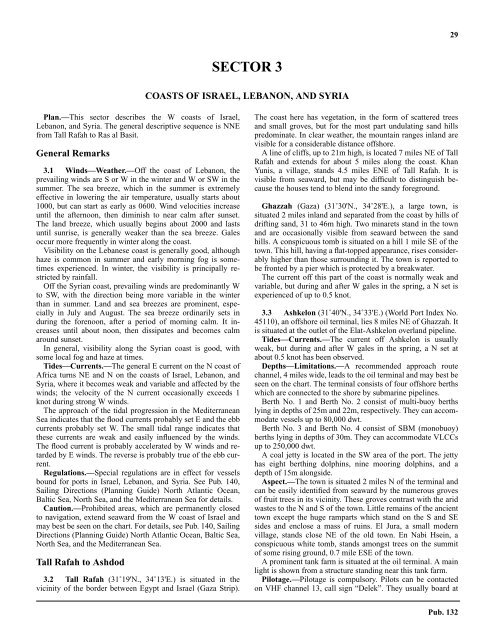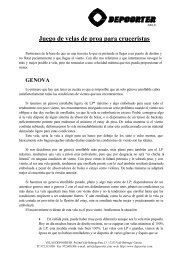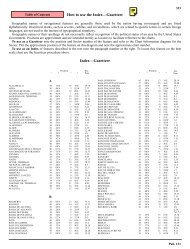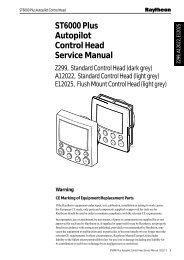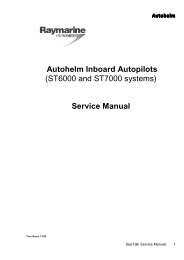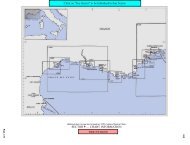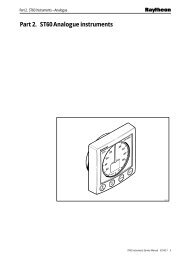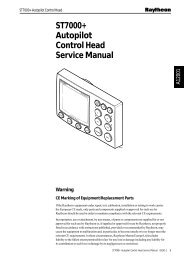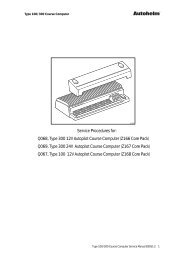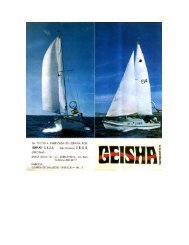You also want an ePaper? Increase the reach of your titles
YUMPU automatically turns print PDFs into web optimized ePapers that Google loves.
29SECTOR 3COASTS OF ISRAEL, LEBANON, AND SYRIA3.0 Plan.—This sector describes the W coasts of Israel,Lebanon, and Syria. The general descriptive sequence is NNEfrom Tall Rafah to Ras al Basit.General Remarks3.1 Winds—Weather.—Off the coast of Lebanon, theprevailing winds are S or W in the winter and W or SW in thesummer. The sea breeze, which in the summer is extremelyeffective in lowering the air temperature, usually starts about1000, but can start as early as 0600. Wind velocities increaseuntil the afternoon, then diminish to near calm after sunset.The land breeze, which usually begins about 2000 and lastsuntil sunrise, is generally weaker than the sea breeze. Galesoccur more frequently in winter along the coast.3.1 Visibility on the Lebanese coast is generally good, althoughhaze is common in summer and early morning fog is sometimesexperienced. In winter, the visibility is principally restrictedby rainfall.3.1 Off the Syrian coast, prevailing winds are predominantly Wto SW, with the direction being more variable in the winterthan in summer. Land and sea breezes are prominent, especiallyin July and August. The sea breeze ordinarily sets induring the forenoon, after a period of morning calm. It increasesuntil about noon, then dissipates and becomes calmaround sunset.3.1 In general, visibility along the Syrian coast is good, withsome local fog and haze at times.3.1 Tides—Currents.—The general E current on the N coast ofAfrica turns NE and N on the coasts of Israel, Lebanon, andSyria, where it becomes weak and variable and affected by thewinds; the velocity of the N current occasionally exceeds 1knot during strong W winds.3.1 The approach of the tidal progression in the MediterraneanSea indicates that the flood currents probably set E and the ebbcurrents probably set W. The small tidal range indicates thatthese currents are weak and easily influenced by the winds.The flood current is probably accelerated by W winds and retardedby E winds. The reverse is probably true of the ebb current.Regulations.—Special regulations are in effect for vesselsbound for ports in Israel, Lebanon, and Syria. See Pub. 140,Sailing Directions (Planning Guide) North Atlantic Ocean,Baltic Sea, North Sea, and the Mediterranean Sea for details.3.1 Caution.—Prohibited areas, which are permanently closedto navigation, extend seaward from the W coast of Israel andmay best be seen on the chart. For details, see Pub. 140, SailingDirections (Planning Guide) North Atlantic Ocean, Baltic Sea,North Sea, and the Mediterranean Sea.Tall Rafah to Ashdod3.2 Tall Rafah (31˚19'N., 34˚13'E.) is situated in thevicinity of the border between Egypt and Israel (Gaza Strip).The coast here has vegetation, in the form of scattered treesand small groves, but for the most part undulating sand hillspredominate. In clear weather, the mountain ranges inland arevisible for a considerable distance offshore.3.2 A line of cliffs, up to 21m high, is located 7 miles NE of TallRafah and extends for about 5 miles along the coast. KhanYunis, a village, stands 4.5 miles ENE of Tall Rafah. It isvisible from seaward, but may be difficult to distinguish becausethe houses tend to blend into the sandy foreground.3.2 Ghazzah (Gaza) (31˚30'N., 34˚28'E.), a large town, issituated 2 miles inland and separated from the coast by hills ofdrifting sand, 31 to 46m high. Two minarets stand in the townand are occasionally visible from seaward between the sandhills. A conspicuous tomb is situated on a hill 1 mile SE of thetown. This hill, having a flat-topped appearance, rises considerablyhigher than those surrounding it. The town is reported tobe fronted by a pier which is protected by a breakwater.3.2 The current off this part of the coast is normally weak andvariable, but during and after W gales in the spring, a N set isexperienced of up to 0.5 knot.3.3 Ashkelon (31˚40'N., 34˚33'E.) (World Port Index No.45110), an offshore oil terminal, lies 8 miles NE of Ghazzah. Itis situated at the outlet of the Elat-Ashkelon overland pipeline.3.3 Tides—Currents.—The current off Ashkelon is usuallyweak, but during and after W gales in the spring, a N set atabout 0.5 knot has been observed.3.3 Depths—Limitations.—A recommended approach routechannel, 4 miles wide, leads to the oil terminal and may best beseen on the chart. The terminal consists of four offshore berthswhich are connected to the shore by submarine pipelines.3.3 Berth No. 1 and Berth No. 2 consist of multi-buoy berthslying in depths of 25m and 22m, respectively. They can accommodatevessels up to 80,000 dwt.3.3 Berth No. 3 and Berth No. 4 consist of SBM (monobuoy)berths lying in depths of 30m. They can accommodate VLCCsup to 250,000 dwt.3.3 A coal jetty is located in the SW area of the port. The jettyhas eight berthing dolphins, nine mooring dolphins, and adepth of 15m alongside.3.3 Aspect.—The town is situated 2 miles N of the terminal andcan be easily identified from seaward by the numerous grovesof fruit trees in its vicinity. These groves contrast with the aridwastes to the N and S of the town. Little remains of the ancienttown except the huge ramparts which stand on the S and SEsides and enclose a mass of ruins. El Jura, a small modernvillage, stands close NE of the old town. En Nabi Hsein, aconspicuous white tomb, stands amongst trees on the summitof some rising ground, 0.7 mile ESE of the town.3.3 A prominent tank farm is situated at the oil terminal. A mainlight is shown from a structure standing near this tank farm.3.3 Pilotage.—Pilotage is compulsory. Pilots can be contactedon VHF channel 13, call sign “Delek”. They usually board atPub. 132


